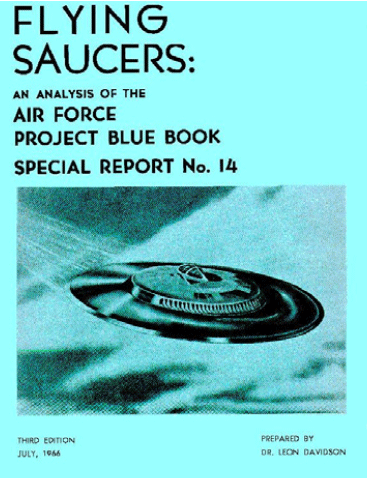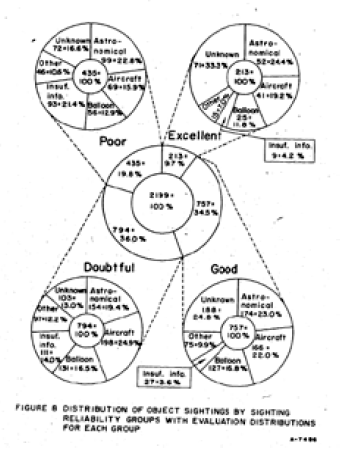.

....do UFO statistics represent a valid pursuit for more knowledge about this elusive phenomenon, or do they merely reflect frustration that none of the individual reports are capable of standing on their own two feet? Are UFO statistics a bold first step...or a desperate last resort? - Allan Hendry1
Project Bluebook’s Special Report 14 is often presented by some UFOlogists as the holy grail of UFOlogy because of some “favorable” statistics that seemed to indicate good UFO reports are actual physical craft of some unknown origin. However, when one looks closely at the methodology, one begins to question these results.
More info does not always help
The Battelle Memorial Institute was responsible for the study that created this report. They evaluated over two thousand UFO reports in order to determine what might be learned from them. The study separated its reports into four categories. They were doubtful, poor, good, and excellent. According to the report, these values were judgements based on several factors:
The experience of the observer de1. duced from his occupation, age, and training. The consistency among the separate 2. portions of the description of the sighting.
The general quality and completeness 3. of the report. Consideration of the observer’s fact-4. reporting ability and attitude, as disclosed by his manner of describing the sighting.
The USAF claimed that if they had more information, they felt they could solve more of these cases. As a result, one would expect the Good and Excellent cases to have the lowest number of uknowns. However, this did not happen in the study. The opposite occurred (24.8% for Good and 33.3% for Excellent - see image to the right). UFOlogists have used these values as a club over the years to beat up the USAF and skeptics. To them it means there is something worth studying and these statistics prove it. However, did the Battelle study really prove anything at all?
GIGO?
What is not mentioned by UFOlogists are the problems associated with the classification of these reports. Experience has shown that occupation does not necessarily guarantee accurate observations and reliability (See Hynek’s UFO report and Hendry’s UFO Handbook).
Additionally, just because a report is complete and full of details that sound consistent does not necessarily mean it is a “good” report. Writing for the Condon study, Dr. William Hartman noticed this when evaluating the Zond IV reports:
An effect important to the UFO problem is demonstrated by the records: the excited observers who thought they had witnessed a very strange phenomenon produced the most detailed, longest, and most misconceived reports, but those who by virtue of experience most nearly recognized the nature of the phenomenon became the least excited and produced the briefest reports.
.

The “excitedness effect” has an important bearing on the UFO problem. It is a selection effect by which the least accurate reports are made more prominent (since the observer becomes highly motivated to make a report), while the most accurate reports may not be recorded.
While the Battelle group did not have such information available to them, they did suspect it and tried to point it out (my emphasis in bold):
...the data were subjective, consisting of qualified estimates of physical characteristics rather than of precise measurements.
Furthermore, most of the reports were not reduced to written form immediately.
The time between sighting and report varied from one day to several years. Both of these factors introduced an element of doubt concerning the validity of the original data, and increased its subjectivity. This was intensified by the recognized inability of the average individual to estimate speeds, distances, and sizes of objects in the air with any degree of accuracy...The danger lies in the possibility of forgetting the subjectivity of the data at the time that conclusions are drawn from the analysis. It must be emphasized, again and again, that the conclusions contained in this report are based NOT on facts, but on what many observers thought and estimated the true facts to be. 4
So, when examining the “Good” and “Excellent” results, one has to be careful in assigning too much weight to the results obtained. One also has to wonder how many of these “Good” and “Excellent” unknowns were reports written weeks, months, or even years after the actual event.
To top this off, one has to wonder how reports can be classified as “Good” or “Excellent” when some of these reports were described as “insufficient information” (3.6% for Good and 4.2% for Excellent)! How can they assign these classifications when the reports had “missing” information?
How many of the “unknowns” in these categories had incorrect/missing information that prevented their identification?
Allan Hendry pointed out in his UFO Handbook that certain characteristics (shape and duration) were missing from about a fourth of all the UFO and IFO reports in the study:
...I would never have DREAMED of making IFO/UFO judgment without important parameters like shape or duration. Instead of dumping these reports into the “insufficient
information” pile where they belong (or better yet, seeking out additional data) they saw fit to make commitments on them. To judge reports like these as “UFOs” and “IFOs” and to include them in chi-square tests is sloppy investigative and statistical process…5
With all of this in mind, can we really draw any valid conclusions about this statistical study? Is it simply a case of Garbage in = Garbage out (GIGO)?
Reevaluation of the Unknowns
Something rarely mentioned by UFO proponents regarding Special report 14 is the attempt to reevaluate the 434 “unknowns” that were created by the initial evaluation. The effort was to identify “possible knowns”, “unknowns”, and “good unknowns”. While the report gave no numbers, they stated that a majority of these “unknowns” could have been observations of familiar objects that just could not be positively identified. It is interesting to note that the reevaluation reduced the numbers of “unknowns” significantly.
It doesn’t say much for those 434 “unknowns” if a majority of them could be considered to have reasonable explanations.
Following this, the report goes on to present what it considered the best cases for futher evaluation:
Thus out of the 434 OBJECT SIGHTINGS that were identified as UNKNOWNS by the data reduction process, there were only 12 that were described with sufficient detail that they could be used in an attempt to derive a model of a “flying saucer”. 6
These final twelve cases involved such events as the Chiles-Whitted sighting, which was probably a bright fireball. Remember, these are the cases that survived the culling and were considered the best. Many of these cases did not even end up on the final list of Bluebooks unknowns! If these cases were the best and found to have possible explanations, what does it say about the data originally used and the results obtained?
Flawed interpretation
The whole idea that Bluebook Special report #14 represents some sort of significance for UFO reports ignores a lot of what is known about people who report UFOs and the “data“ that is in these reports. The study used a subjective methodology to classify and quantify the reports for analysis. The authors of the report recognized this and stated so. However, the UFO proponents, who like to interpret these results as something truly significant, seem to have ignored their warnings.
Notes and references
Hendry, Allan. 1. The UFO Investigators Handbook. London: Sphere Books Ltd. 1980. p. 269
United States Air Technical Intel2.
ligence Center. Project Blue Book Special Report NO. 14: Analysis of Reports of Unidentified Aerial Objects.
Project No. 10073. 5 May 1955. P. 11
Condon, Edward U., et al., eds. 3. Scientific
Study of Unidentified Flying Objects. New York: Bantam, 1968. P. 574
United States Air Technical Intel4.
ligence Center. Project Blue Book Special Report NO. 14: Analysis of Reports of Unidentified Aerial Objects.
Project No. 10073. 5 May 1955. P. 3-4
Hendry, Allan. 5. The UFO Investigators Handbook. London: Sphere Books Ltd. 1980. p. 267
United States Air Technical Intel6.
ligence Center. Project Blue Book Special Report NO. 14: Analysis of Reports of Unidentified Aerial Objects.
Project No. 10073. 5 May 1955. P. 77-78.
.
Quelle: SUNlite 4/2011
4921 Views
